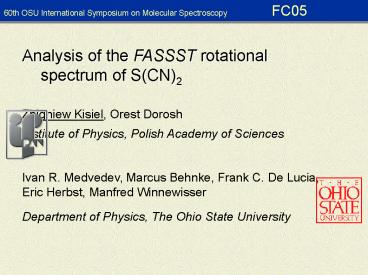FC05, 60th OSU Symposium
1 / 20
Title: FC05, 60th OSU Symposium
1
60th OSU International Symposium on Molecular
Spectroscopy FC05
Analysis of the FASSST rotational spectrum of
S(CN)2 Zbigniew Kisiel, Orest Dorosh Institute
of Physics, Polish Academy of Sciences Ivan R.
Medvedev, Marcus Behnke, Frank C. De Lucia, Eric
Herbst, Manfred Winnewisser Department of
Physics, The Ohio State University
2
The rmr geometry of S(CN)2
175.14(7)o
1.699(1) Å
1.159(1) Å
98.38(6)o
Demaison et al. J.Mol.Struct. 376, 399 (1996)
3
Previous studies by rotational spectroscopy
- Arnold, Dreizler, Rudolph Z.Naturforsch. 19a,
1428 (1964) - cm-wave rotational spectrum of parent isotopomer
assigned and dipole moment measured, mb
3.01(1) D - Pierce Nelson JCP 43, 3423 (1965)
- ground state A,B,C for the parent 34S, 13C,
15N isotopomers, and for v41 satellite in parent - Jemson Gerry JMS 124, 481 (1987)
- ground state measurements extended (in cmw
region) and constants up to sextic determined
4
Lowest energy vibrational states in S(CN)2
Frequencies are unscaled B3LYP/6-31G(d,p) Other
modes (cm-1) obs. calc. G n2 672
685 A1 n6 690 688 B1 n5 2180 2293 B1 n1
2308 2308 A1
w 3 496
A1
w 9 372
w 8 366
A2
B2
w 7 328
B1
w 4 122 cm-1 A1
5
Preparation of S(CN)2 and FASSST spectrum
- AgCN in CS2 SCl2
- ? reacted for ?1 hour
- ? CS2 distilled off
- S(CN)2 yellowish crystals kept in dry ice
- FASSST spectrum recorded over 110 - 374 GHz using
three different mmw sources - Sample flow through cell eliminating volatile
impurities - Spectrum recorded at room temperature and at 190oC
6
Analysis carried out using the AABS software
package
- Spectra and predictions displayed alongside with
two previewing programs - Graphical assignment and automated transfer of
frequencies and quantum numbers to datafiles - Fitting and predictions with ASFIT/ASROT and with
H.M.Picketts SPFIT/SPCAT - Package is expected to be suitable for analysis
of other types of broadband, rotationally
resolved spectra tests are encouraged
AABS Assignment and Analysis of Broadband
Spectra available on the PROSPE webpage
http//info.ifpan.edu.pl/kisiel/prospe.htm
7
Vibrational satellites of characteristic R-type
transitions
?4 0
320,32 ? 311,31 321,32 ? 310,31
1
2
3
4
8
(No Transcript)
9
(No Transcript)
10
Synthetic overview of the ground state dataset
Symbol size is proportional to
(nobs-ncalc)/dn, Red symbols denote (nobs-ncalc)
gt 3 dn
11
Aspects of FASSST calibration
Absolute calibration, FASSST vs PLL (Medvedev et
al., JMS 228, 314,2004)
Linewidths from automatic peakfinder in AABS
12
Linewidths in FASSST spectra (FWHH /MHz)
- Spectra of two different molecules recorded ca 1
year apart
13
Constants for the ground state of 32S(CN)2
octics
GAMESS
FCONV
VIBCA
0.96f scaled B3LYP/6-31G(d,p), calculation
14
Changes in constants on excitation of the n4
bending mode
A
? quartics
A,B,C ?
DK
B
C
sextics ?
? octics
fJK
15
Lowest energy vibrational states in S(CN)2
Frequencies are unscaled B3LYP/6-31G(d,p) Other
modes (cm-1) obs. calc. G n2 672
685 A1 n6 690 688 B1 n5 2180 2293 B1 n1
2308 2308 A1
w 3 496
A1
w 9 372
w 8 366
A2
B2
w 7 328
B1
w 4 122 cm-1 A1
16
Statistical weights in rotational transitions of
S(CN)2
Successive R-type transitions pairs for same J
and K-12?1 and K-11?2 21 weights are due to
symmetry equivalent 14N nuclei with I 1.
The AABS package requires only a single keystroke
to jump between successive regions of the
spectrum. Alternatively a switch to the
Loomis-Wood display can be made
17
Loomis-Wood plot for S(CN)2 illustrating
statistical weights
18
Assignment of vibrational satellites
Working Weight Inertial defect (uA2)
Mode label obs. calc.
n ?calc G gs 0.49037(2) 0.480 1
1.38536(4) 1.370 n4 122 A1
N - -0.79067(4) -0.852 n7 323 B1 NN -
0.712(2) 0.688 n8 366 B2 NNN
1.03(7) 1.131 n9 372 A2 L
0.97(4) 0.947 n3 496 A1
Weight statistical weights relative to the
ground state, stands for unchanged weights,
- denotes reversed weights
19
34S(CN)2
20
Conclusions
- Spectroscopic constants determined for the ground
state and nine different vibrational excited
states - First excited states of five different normal
modes measured - Extensive results also for the 34S isotopomer and
some for 13C isotopomer - Highly efficient AABS software package developed
in response to the need to process and manage
data for many states simultaneously - No signs of quantum monodromy barrier to
linearity very high (but have you seen talk TH07
on NCNCS ? )
To do
- Analysis of interstate interactions ?
























![get [PDF] DOWNLOAD A Symposium of Connectivism: Definitive Final Form Editio](https://s3.amazonaws.com/images.powershow.com/10059427.th0.jpg?_=20240619078)
![[PDF] DOWNLOAD My Beautiful Sister Happy 60th Birthday Notebook, B](https://s3.amazonaws.com/images.powershow.com/10060831.th0.jpg?_=202406210111)




![[PDF] DOWNLOAD My Beautiful Sister Happy 60th Birthday Notebook, B](https://s3.amazonaws.com/images.powershow.com/10067589.th0.jpg?_=202406280212)
![[PDF] DOWNLOAD Methuen Drama's Modern Plays: 60th Anniversar](https://s3.amazonaws.com/images.powershow.com/10093403.th0.jpg?_=20240807054)